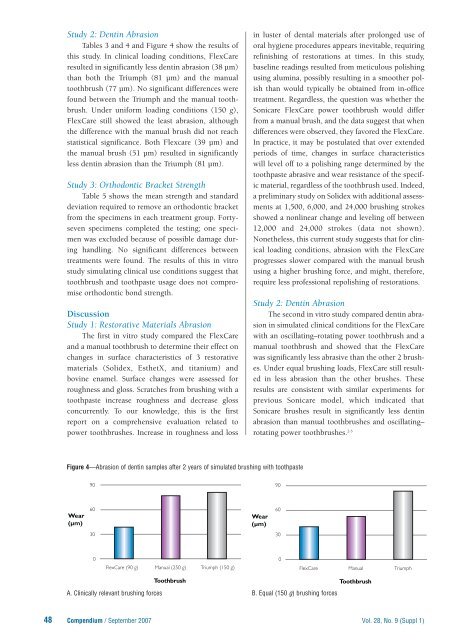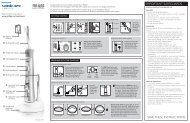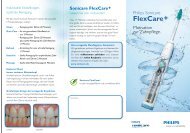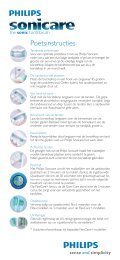Philips Sonicare FlexCare - Sonicare.com - Sonicare
Philips Sonicare FlexCare - Sonicare.com - Sonicare
Philips Sonicare FlexCare - Sonicare.com - Sonicare
Create successful ePaper yourself
Turn your PDF publications into a flip-book with our unique Google optimized e-Paper software.
Study 2: Dentin Abrasion<br />
Tables 3 and 4 and Figure 4 show the results of<br />
this study. In clinical loading conditions, <strong>FlexCare</strong><br />
resulted in significantly less dentin abrasion (38 µm)<br />
than both the Triumph (81 µm) and the manual<br />
toothbrush (77 µm). No significant differences were<br />
found between the Triumph and the manual toothbrush.<br />
Under uniform loading conditions (150 g),<br />
<strong>FlexCare</strong> still showed the least abrasion, although<br />
the difference with the manual brush did not reach<br />
statistical significance. Both Flexcare (39 µm) and<br />
the manual brush (51 µm) resulted in significantly<br />
less dentin abrasion than the Triumph (81 µm).<br />
Study 3: Orthodontic Bracket Strength<br />
Table 5 shows the mean strength and standard<br />
deviation required to remove an orthodontic bracket<br />
from the specimens in each treatment group. Fortyseven<br />
specimens <strong>com</strong>pleted the testing; one specimen<br />
was excluded because of possible damage during<br />
handling. No significant differences between<br />
treatments were found. The results of this in vitro<br />
study simulating clinical use conditions suggest that<br />
toothbrush and toothpaste usage does not <strong>com</strong>promise<br />
orthodontic bond strength.<br />
Discussion<br />
Study 1: Restorative Materials Abrasion<br />
The first in vitro study <strong>com</strong>pared the <strong>FlexCare</strong><br />
and a manual toothbrush to determine their effect on<br />
changes in surface characteristics of 3 restorative<br />
materials (Solidex, EsthetX, and titanium) and<br />
bovine enamel. Surface changes were assessed for<br />
roughness and gloss. Scratches from brushing with a<br />
toothpaste increase roughness and decrease gloss<br />
concurrently. To our knowledge, this is the first<br />
report on a <strong>com</strong>prehensive evaluation related to<br />
power toothbrushes. Increase in roughness and loss<br />
in luster of dental materials after prolonged use of<br />
oral hygiene procedures appears inevitable, requiring<br />
refinishing of restorations at times. In this study,<br />
baseline readings resulted from meticulous polishing<br />
using alumina, possibly resulting in a smoother polish<br />
than would typically be obtained from in-office<br />
treatment. Regardless, the question was whether the<br />
<strong>Sonicare</strong> <strong>FlexCare</strong> power toothbrush would differ<br />
from a manual brush, and the data suggest that when<br />
differences were observed, they favored the <strong>FlexCare</strong>.<br />
In practice, it may be postulated that over extended<br />
periods of time, changes in surface characteristics<br />
will level off to a polishing range determined by the<br />
toothpaste abrasive and wear resistance of the specific<br />
material, regardless of the toothbrush used. Indeed,<br />
a preliminary study on Solidex with additional assessments<br />
at 1,500, 6,000, and 24,000 brushing strokes<br />
showed a nonlinear change and leveling off between<br />
12,000 and 24,000 strokes (data not shown).<br />
Nonetheless, this current study suggests that for clinical<br />
loading conditions, abrasion with the <strong>FlexCare</strong><br />
progresses slower <strong>com</strong>pared with the manual brush<br />
using a higher brushing force, and might, therefore,<br />
require less professional repolishing of restorations.<br />
Study 2: Dentin Abrasion<br />
The second in vitro study <strong>com</strong>pared dentin abrasion<br />
in simulated clinical conditions for the <strong>FlexCare</strong><br />
with an oscillating–rotating power toothbrush and a<br />
manual toothbrush and showed that the <strong>FlexCare</strong><br />
was significantly less abrasive than the other 2 brushes.<br />
Under equal brushing loads, <strong>FlexCare</strong> still resulted<br />
in less abrasion than the other brushes. These<br />
results are consistent with similar experiments for<br />
previous <strong>Sonicare</strong> model, which indicated that<br />
<strong>Sonicare</strong> brushes result in significantly less dentin<br />
abrasion than manual toothbrushes and oscillating–<br />
rotating power toothbrushes. 2-5<br />
Figure 4—Abrasion of dentin samples after 2 years of simulated brushing with toothpaste<br />
90<br />
90<br />
Wear<br />
(µm)<br />
60<br />
Wear<br />
(µm)<br />
60<br />
30<br />
30<br />
0<br />
<strong>FlexCare</strong> (90 g) Manual (250 g) Triumph (150 g)<br />
0<br />
<strong>FlexCare</strong> Manual Triumph<br />
A. Clinically relevant brushing forces<br />
Toothbrush<br />
B. Equal (150 g) brushing forces<br />
Toothbrush<br />
48 Compendium / September 2007 Vol. 28, No. 9 (Suppl 1)










